Information systemsThe combination of people, information technology, and business processes to accomplish a business objective. are the combination of people, information technology, and business processes to accomplish a business objective.
Every information system (IS) has people, processes, and information technology. In fact, many IS professionals add most of their value working with people and processes. They manage the programmers but typically avoid programming themselves. We can represent an information system as a triangle with people, processes, and information technology (computers) on the three vertices. The three parts of an information system are often referred to as the information systems triangleEvery information systems consists of people, business processes, and information technology..
Consider the popular trend of letting the TV audience vote on some talent shows such as Dancing with the Stars. The voting is managed by a sophisticated information system. The voters are the people involved with the system. Voters can cast the votes by phone, by text, or by online poll—three different information technologies. A central server at ABC records and tallies the votes. The business processes include the phone, texting, and online procedures—how and when to cast votes, and rules limiting the number of votes from each household.
In November 2010, ABC had to defend the legitimacy of its business processes when detractors claimed that Bristol Palin, daughter of political candidate, Sarah Palin, received an inflated vote tally from Tea Party supporters. Some of these supporters bragged on blogs about how they had circumvented the ABC business processes to record multiple votes for Bristol. ABC claims that it has systems in place to spot and discount suspicious voting activity. They have publicly revealed some, but not all, of these fraud detection systems. At this point we don’t know for sure if fraudulent votes got through. For more on this story see for example: http://insidetv.ew.com/2010/11/19/dwts-bristol-palin-tea-party-voting-conspiracy/.
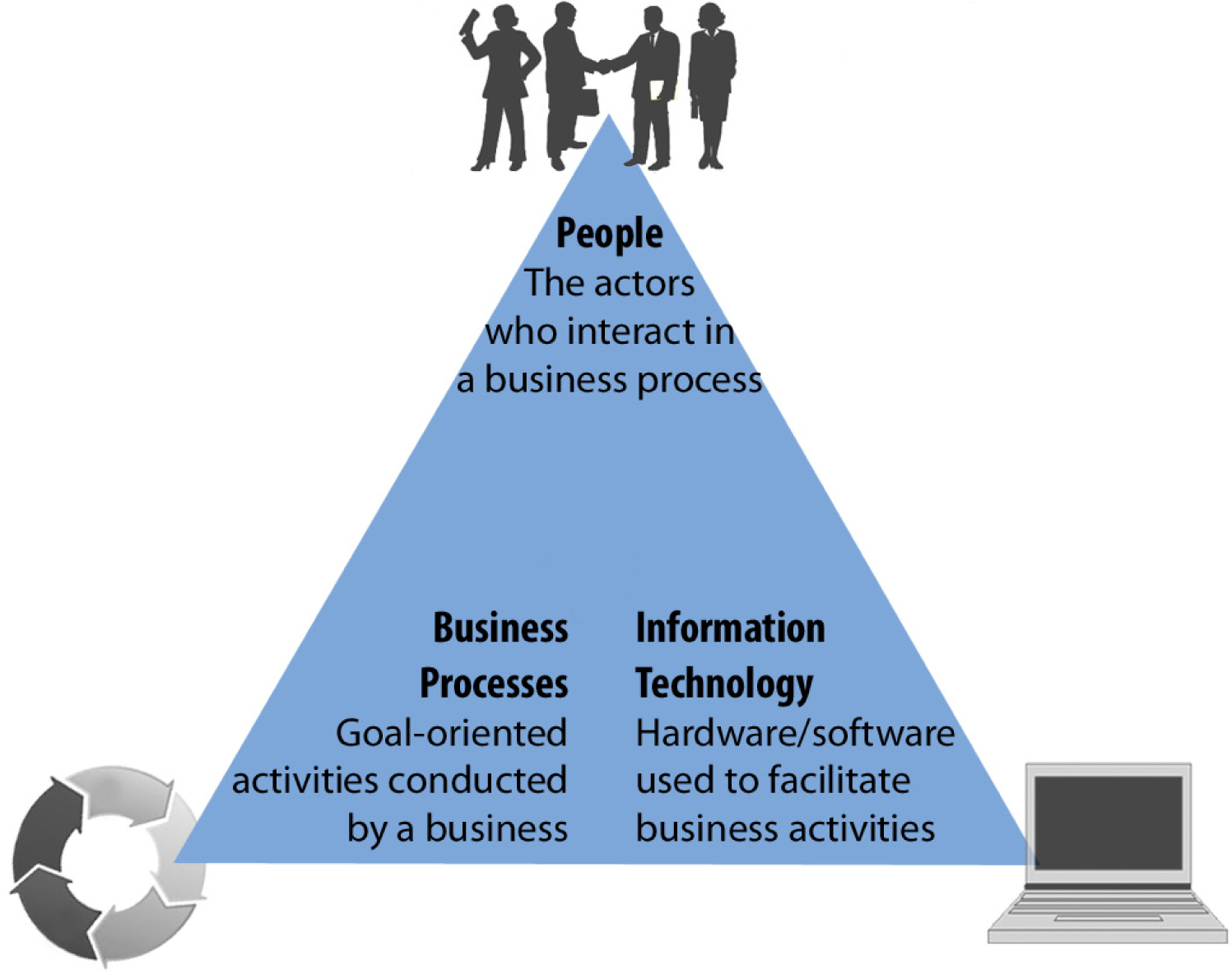
The three parts of the information systems triangle must interact in concert to realize business objectives. The job of the IS professional is to ensure that a balance is maintained and enhanced for the good of all the actors and the business as a whole.
Information systems professionals work with others to design and customize the systems that you interact with everyday. When you register at a hospital, the information goes into an information system designed to support administrative reporting and insurance processing. When you buy from Amazon.com, the information goes into an information system designed to support customer relationship management.
Every information system is designed to make someone’s life easier. Unfortunately, that someone is not always the consumer. When was the last time that you had a good registration experience at a hospital? That system probably was not designed with you in mind—but rather designed to support backend reporting for the hospital administration and by proxy for the government and insurance companies. So the administrators are happy, but not the customers. From the hospital’s point of view there is no business need to make the registration experience extraordinarily pleasant. They are betting that you will not choose your hospital based on how difficult it was to register.
Amazon.com, by contrast, delivers an extraordinary experience to its customers so that they will stay loyal. Amazon practices user centered designDesigning websites and applications to meet the needs of the user. While this may seem to be common sense, in practice it does not often happen—especially in internal corporate settings. How user centered are the systems at your college or university?—designing to meet the needs of the user. However, the clever folks at Amazon also have tremendous backend reporting. So it is possible to design systems that please customers and administrators simultaneously—but it takes a bit more effort.
What would hospital systems look like if they were designed to Amazon standards? Imagine 1-click appointments, 1-click payments, shielding the client from the insurance companies. How about an integrated patient record of all past procedures?
The world will continue to gravitate toward Amazon style systems. In the end it is good business to make everyone happy—employees, customers, and administrators. It is also the right thing to do. Think back to the hospital. In a competitive market, maybe you would choose the better customer experience. A hospital worker might choose to work for the hospital with the more user friendly patient information system. No one likes to be yelled at by unhappy customers.
It doesn’t take much to improve the user experience (UX) of a system. You have to design a user interface (UI) anyway—why not make it a good one? In the words of Hall of Fame basketball coach John Wooden, “If you don’t have time to do it right, when will you have time to do it again?”
Consider the tremendous success of Apple Computer. One of the main advantages that Apple has over its rivals is that it carefully analyzes how people best interact with technology, develops requirements based on that analysis and then designs elegant computers, the iPhone, iPad, iTunes, and so forth based on those requirements.
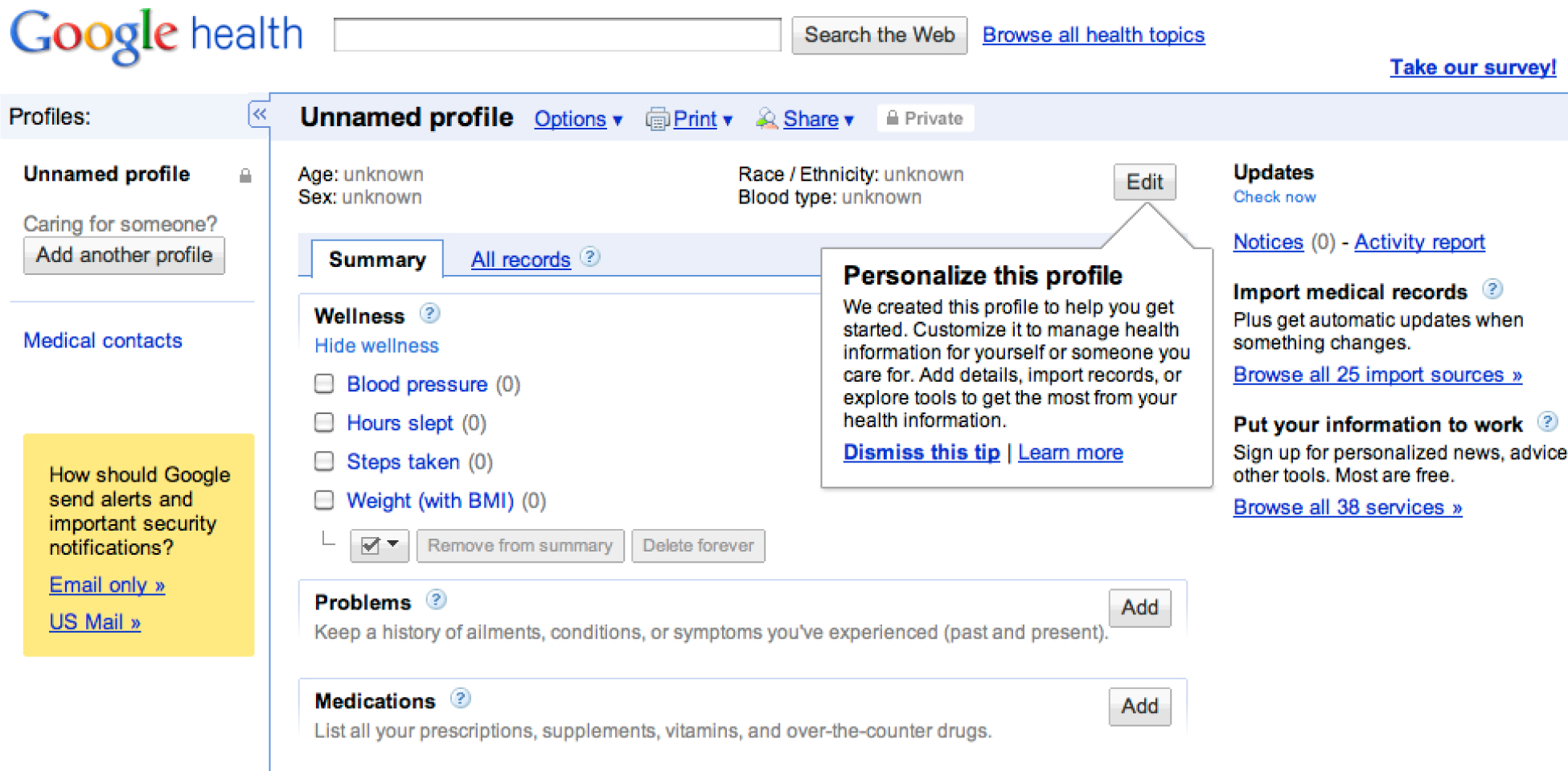
Google Health, pictured here, has created a user centered patient record—and for free! It will be interesting to see if hospitals adopt it.
Marketing, accounting, finance, manufacturing – there are many different professional goals and types of work in the business world. There are also many different industries where this work can be performed – manufacturing, retail, banking, healthcare. No matter what your career goal is or what industry interests you, your success and the success of the business rely on your ability to recognize opportunities where information systems can be used to improve performance. In most lines of work, you will need to store information in and retrieve information from databases. You will have to create persuasive and professional reports and presentations to convince others that your ideas make sense. Using Microsoft Excel and other tools, you will analyze data to find patterns and trends to aid decision-making. You will manage your relationships with contacts and clients using customer relationship management systems. The business’s success will depend on you leading efforts that use technology to support the introduction of new products, efficiently manage supply chains, and effectively manage complex financial activities. Retailers rely on past purchase data to develop sales forecasts and predict purchase behavior. Most businesses utilize collaboration technologies to bring together employees from all over the world to solve problems. Your ability to recognize opportunities to use information technology to create business value is central to both your success and that of your firm.
A career in information systems is full of action, problem-solving, and teamwork. It is the goal of information systems professionals to bridge the knowledge gap between business users and technologists, and thus IS professionals must be fluent in both worlds. Work in the field of information systems is exciting, fun, and fast-paced. There is always a new team to work with and new technology to learn about, and projects move quickly leaving openings for new endeavors. In a recent report published in The Wall Street Journal, information systems professionals were tied for the highest percentage of college graduates that were satisfied with their career path. See http://finance.yahoo.com/college-education/article/111000/psych-majors-not-happy-with-options?mod=edu-continuing_education.
When preparing to become an IS professional, students focus on learning about the types of systems that exist, what they offer to businesses, best practices for implementation, and the advantages and disadvantages of each. Students also focus on how to work with business users and discover what their system needs are and how they can best be served by information systems. Information systems professionals focus on solving problems in businesses through the use of information systems.
When students start their careers, they frequently work on teams that connect businesspersons with the appropriate system solution for their situation. Usually the organizations they work for adopt a set of best practices to create consistency across project teams. Through the use of these best practices, IS professionals determine what options are available, consider the pros and cons of each, design a customized solution to match the specific business, and develop a plan on how to best implement the information system, including rollout phases and training.
As mentioned, IS professionals typically work in teams. This is because the projects are usually very large and have many interworking pieces. As a result, IS professionals specialize in a particular type of work and contribute their expertise in this area. Specializations include system analysts, software developers, database administrators, and project managers.
Information systems as a career is attractive to many individuals because of the traits above. However, it is also engaging because it is a career in which you get to work on making people’s lives easier. IS professionals focus on developing systems that businesspersons will use to create efficiency and increase their performance. IS professionals design systems that help businesspersons make better decisions (decision support systems) and lead organizations (executive dashboards). Systems are also created to keep track of materials (supply chain management systems) and customers (customer relationship management systems). And given the important role of information in modern organizations, IS professionals record, monitor, and analyze data to learn how the business can improve (business intelligence systems). IS professionals work to design these systems to be more usable, more efficient, and more informative. This book will discuss these topics and allow you to experience many of them. It walks you through what it is like to be an IS professional, rather than telling you about it.
The key to successful information systems is good design. But what makes a good design? A number of disciplines weigh in on this topic. We will look at design from a number of different perspectives. Whenever possible we will contrast good and bad designs.
Different people use the word design in different contexts. When IS professionals speak of design, they are referring to business processes. Problems must be analyzed and requirements documented before solutions are designed, developed, and implemented. After all if the design does not satisfy the business need, then what’s the point? However, satisfying the business need is really a baseline standard. The vilified hospital system described earlier meets the business need of registering patients. And yet its design is in other ways lacking. Similarly, fast food meets the need for feeding one’s hunger. However, we want to be metaphorically better than fast food in our designs.
UsabilityDescribes how easy the system is to use and navigate—especially for novice users. describes how easy the system is to navigate. The easier the system is to navigate, the less time a user will need to spend learning to use the system. A more usable system also leaves less room for error. Usability theory provides rules of thumb (heuristics) that document best practice conventions for designing a user interface. Amazon.com has one of the most usable online systems because they follow established conventions. Following conventions tremendously increases the potential acceptance of your website or app.
Graphic designDescribes the visual appeal and organization of the user interface. refers to the visual appeal and organization of the user interface. There is obviously some overlap here with usability. Usable systems typically adhere to at least some graphic design rules. However, a usable system could be bland and uninteresting. Employing graphic design principles helps ensure that the system will have visual appeal. Designs also need to fit with the overall brand of the client. Existing colors, fonts, and logos are all a part of the brand for which the system is being created.
Analytical DesignDescribes how best to represent information—especially quantitative information—so that it communicates clearly and truthfully. describes how to best represent information—especially quantitative information—to communicate clearly and truthfully. Every information systems project has quantitative dimensions associated with project management. These include estimating costs, time schedules, and so forth.
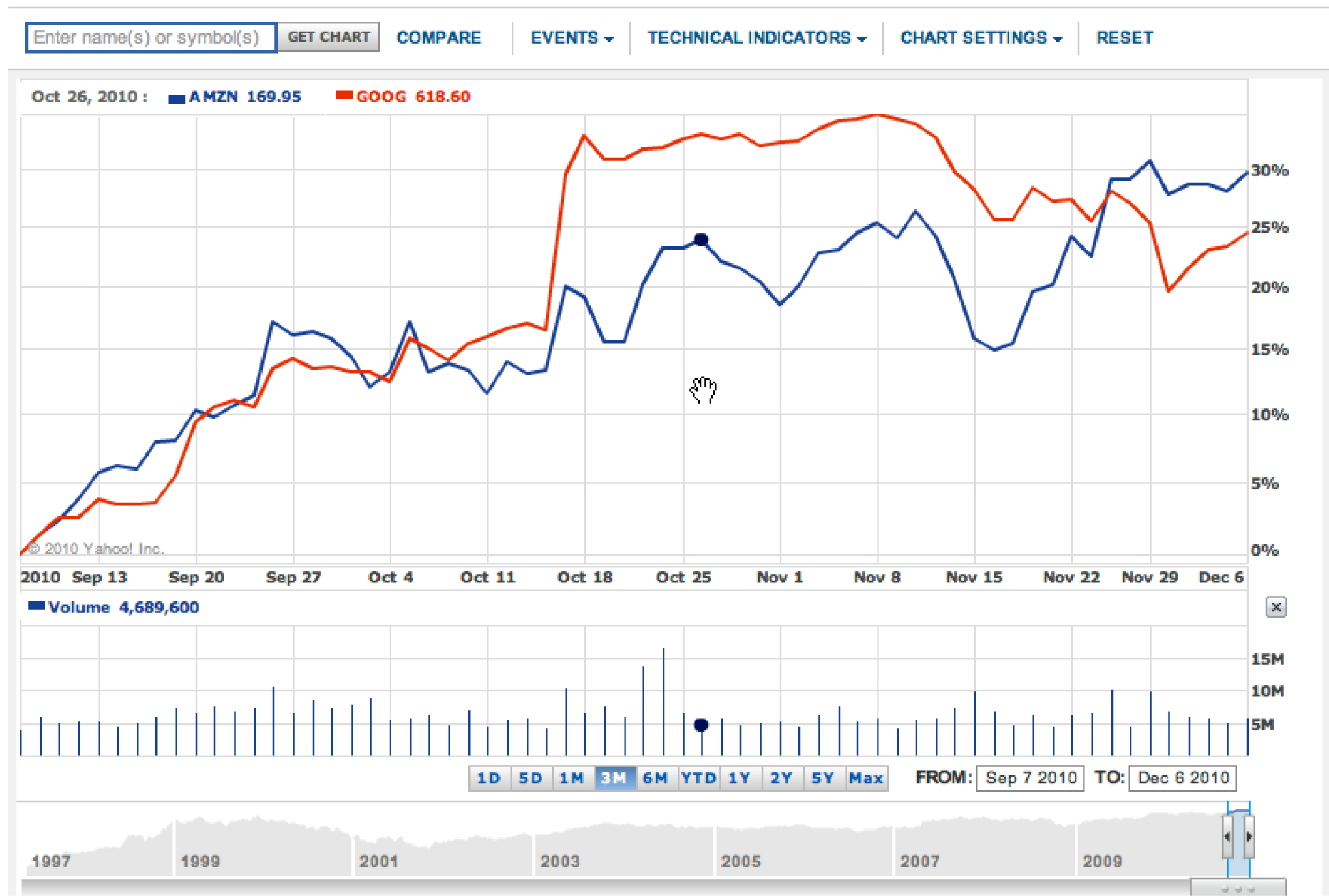
The convergence of usability, graphic design, and analytical design on Yahoo Finance. This graph shows the three month stock price for Amazon vs. Google. From a usability standpoint it could not be easier to request the graph. Type the company name and it suggests the stock ticker symbol. Also, as you move your cursor (the hand), the black dot on the line moves as well, and the numbers on the top left update to display values for the date you are passing over—very slick! The graphic design is excellent—muting the underlying grid so that the data stands out by contrast. The analytical design is also first rate. Hundreds of data points are effortlessly represented. We see the trading volume on each day. At the bottom, the stock price is placed in context over a multi year period. In sum, we have a tremendous amount of information beautifully represented without clutter. Think about this the next time you see an impoverished PowerPoint graph with four bars representing four data points.
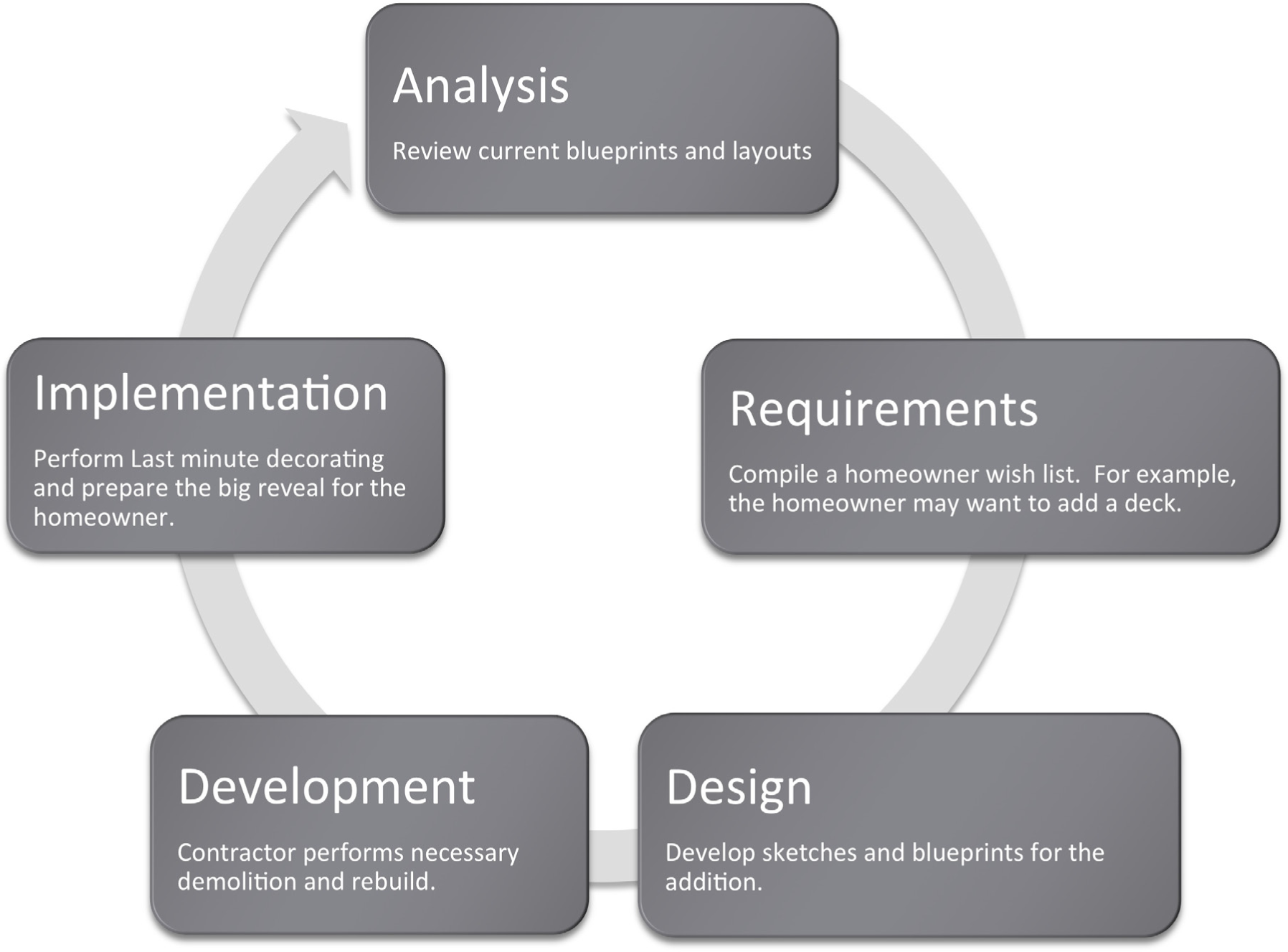
Information systems are designed using the systems development life cycle (SDLC)A method for designing information systems. The life cycle proceeds through the following stages: an analysis of the current state, development of requirements, design of a solution, development from the design and finally to implementation or roll out of the solution.. The SDLC is to a large extent common sense spelled out in stages. First, analyze the current situation. Then specify the requirements that a solution should embody. The next stage is to design a solution (no programming yet). Then the system is developed (programmed) and tested. Finally, the system goes live for the end users as it is implemented in the business setting. To review, the five phases are:
In this course we will cover all five stages. However we will focus most heavily on the first three stages for two reasons. First, because that is where IS professionals tend to spend most of their time and second because it is much easier to make changes to a system when in the planning stages, than after code has already been generated.
It is good to frequently interact with the end user and show them screen mockupsNon-functioning pages of a website or app that are generated in a drawing program such as Photoshop, Omnigraffle, or even PowerPoint. and a systems architecture diagramA diagram that shows the organization of a website or app. A systems architecture diagram is sometimes also called a site map. of what the final system will look like. The systems architecture is a hierarchy diagram of the flow of the website or app—what the relationship between the pages of the system will be. It is sometimes called a site map. Ideally the systems architecture is done on paper with sticky notes that can be moved around at will by multiple users. A final systems architecture can be represented as a hierarchy chart in PowerPoint.
Once the systems architecture is complete, wireframesA sketch of what the website or app page will look like. A wireframe has less detail filled in than a mockup. or mockups of the individual pages may be constructed. Mockups are non-functioning pages generated in a drawing program such as PhotoShop, Omnigraffle (Mac), or even PowerPoint. PowerPoint turns out to be a fairly respectable mockup tool—especially when working off of some predefined templates.
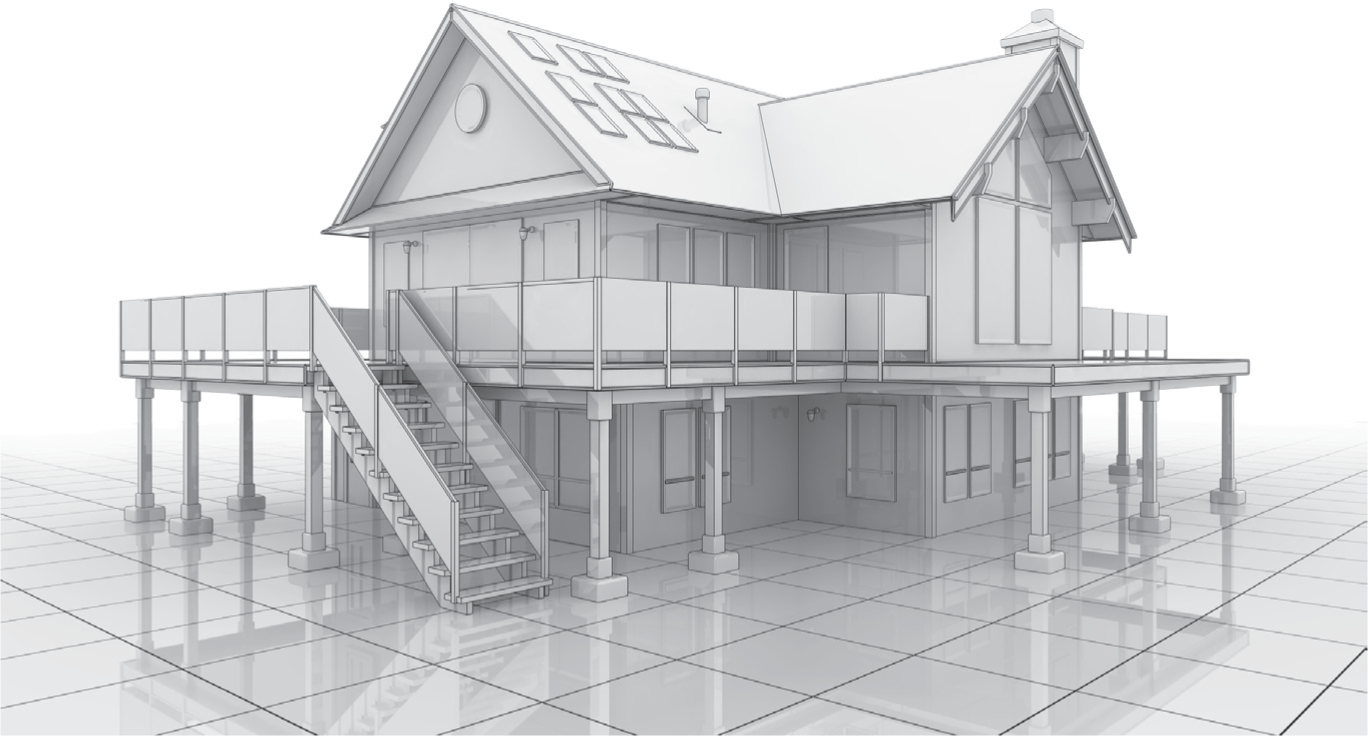
The SDLC in action. By analogy think of home improvement shows on TV. such as Curb Appeal. They typically follow a similar life cycle when improving a home. The current state of the home is analyzed in consultation with the resident. During this stage the residents reveal their requirements for a solution. For example, they might want a way to interact more with the neighbors. Next the designer produces a plan to meet those requirements. For example, a French door in the living room leading to a front deck from which to interact with the neighbors. Actually blowing a hole through the wall and installing a deck is the development stage. If the design is good and workmanship good, the owner is normally delighted with the solution. At least they seem to be on TV. The illustration below helps to tease out some of the equivalencies.
Most information systems can be grouped into three broad classifications—enterprise systems (ES), knowledge management/collaboration systems, and business intelligence (BI) systems. These collectively comprise the information systems architectureThe high level view of corporate systems—usually divided into enterprise systems, knowledge management/collaboration systems and business intelligence systems. for an enterprise.
Enterprise systemsSystems that manage day to day transactions of the business. are used to manage the day to day business processes. Supply chain managementControlling the flow of raw materials and finished products into and out of the business. (SCM) controls inbound and outbound logistics. Customer relationship managementControlling communications with the customer to advance marketing goals (CRM) manages communications and marketing initiatives directed at customers. However, the grandaddy of them all are enterprise resource planningThe largest systems of all. ERP systems tie together all aspects of the business from accounting to the shop floor. (ERP) systems that control business transactions from accounts payable/receivable to product movement on the factory floor.
If this seems dense now, don’t worry about it. Books have been written about all these pieces. What is important for you to see is that ideally all the systems are smoothly coordinated so that management makes information driven decisions.
All of these enterprise systems communicate and share information as needed. They also store each of their activities in databases. At regular intervals these databases are copied into a centrally located data warehouse. The copying process is called extract, transform and load (ETL). Data is extracted from the multiple databases, transformed to a common format, and then loaded into the data warehouse.
The data warehouseA repository of corporate data collected from many corporate databases. then becomes a gold mine of data about the business. The beauty of the data warehouse is that it can be queried offline without interrupting operations of the business. However, the data warehouse is only as useful as the systems that query it for information. These are called business intelligenceThe process of analyzing data to spot trends and opportunities. (BI) systems. One of the most well known types of BI systems is for advanced reporting or data miningA form of BI that automatically looks for trends or patterns in the data.. BI systems look to spot trends in the data and then convey that information to the appropriate management level. For example, BI systems discovered years ago that diapers and beer were often purchased in the same supermarket visit. Clever marketing sleuths concluded that dad sent out to buy diapers was also picking up a 6 pack on his way out of the store. This creates opportunities for product placement—locating the beer closer to the diapers.
Knowledge managementCapture and index knowledge from past projects usually in text form. and collaboration systemsAllow multiple users to work on projects together—even when geographically separated. are ways that members of the organization capture and institutionalize organizational knowledge. The most familiar types of systems are internal websites for the company as well as blogs and wikis. However, leading organizations will also require that reports be filed in a systematic way to allow for easy retrieval in case the organization encounters a similar business problem in the future.
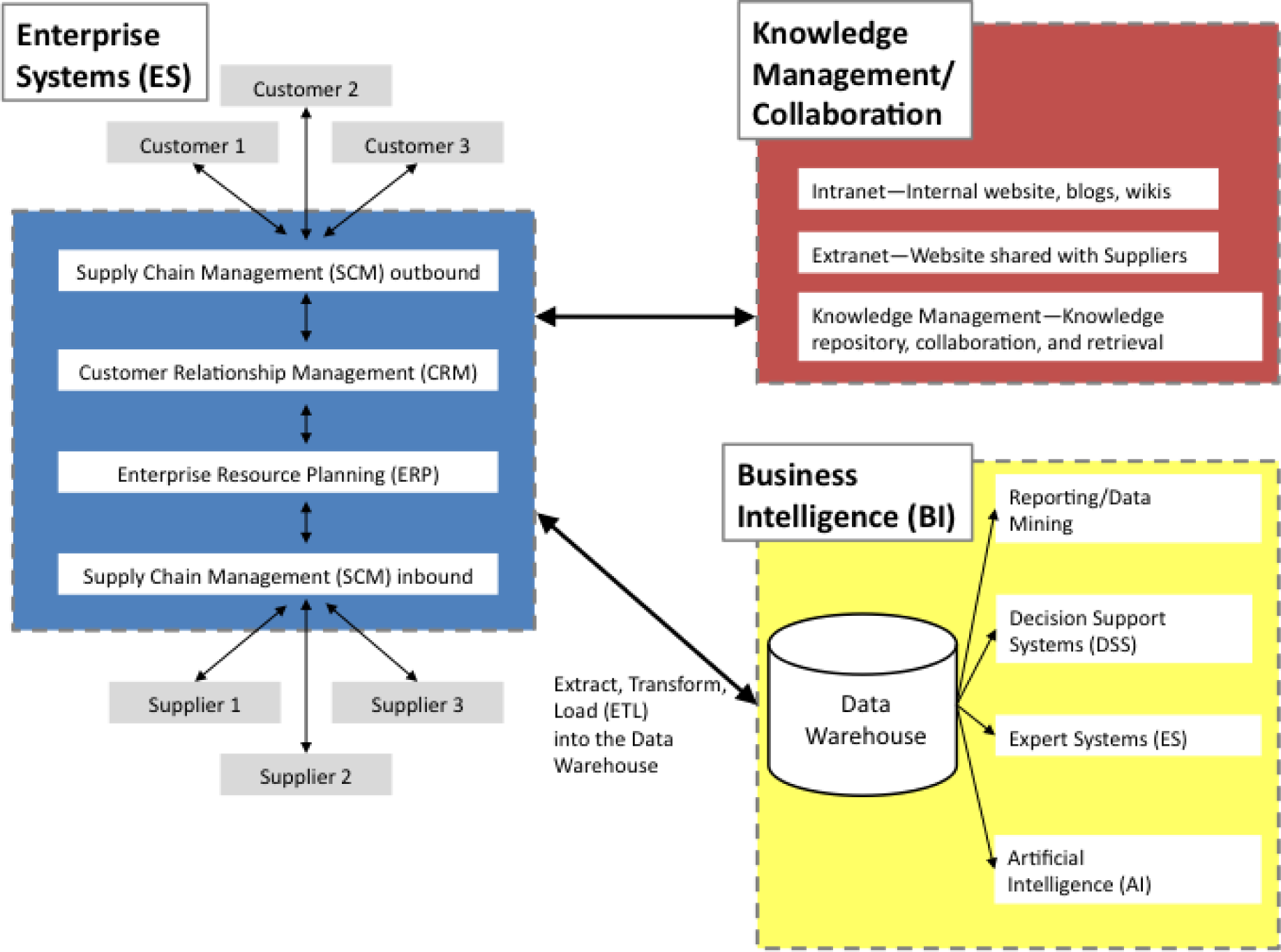
The big picture of information systems architecture. We will touch all these systems—albeit at a surface level. We will create a store that handles customer relationship management (CRM). Blackboard and similar systems are examples of collaboration systems. Finally, we will analyze our sales data as a form of business intelligence.